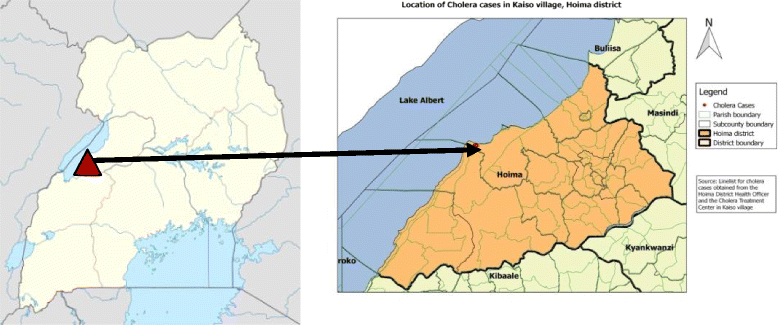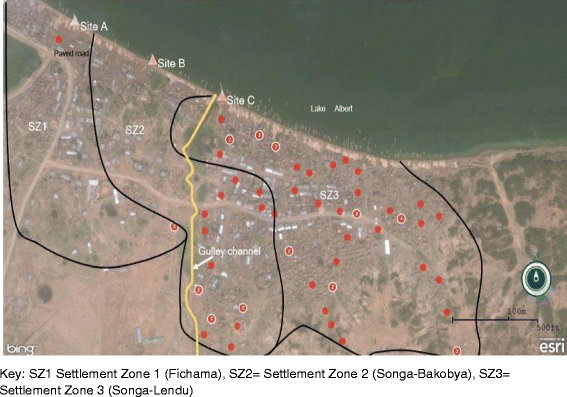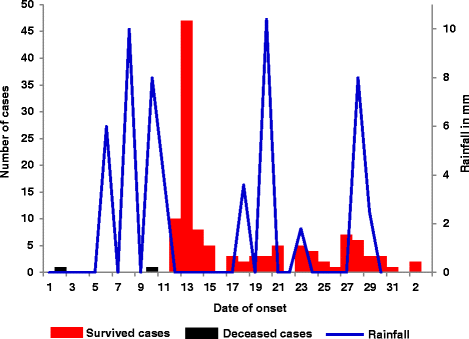Cholera outbreak caused by drinking lake water contaminated with human faeces in Kaiso Village, Hoima District, Western Uganda, October 2015
- PMID: 28992811
- PMCID: PMC5634859
- DOI: 10.1186/s40249-017-0359-2
Cholera outbreak caused by drinking lake water contaminated with human faeces in Kaiso Village, Hoima District, Western Uganda, October 2015
Abstract
Background: On 12 October 2015, a cholera outbreak involving 65 cases and two deaths was reported in a fishing village in Hoima District, Western Uganda. Despite initial response by the local health department, the outbreak persisted. We conducted an investigation to identify the source and mode of transmission, and recommend evidence-led interventions to control and prevent cholera outbreaks in this area.
Methods: We defined a suspected case as the onset of acute watery diarrhoea from 1 October to 2 November 2015 in a resident of Kaiso Village. A confirmed case was a suspected case who had Vibrio cholerae isolated from stool. We found cases by record review and active community case finding. We performed descriptive epidemiologic analysis for hypothesis generation. In an unmatched case-control study, we compared exposure histories of 61 cases and 126 controls randomly selected among asymptomatic village residents. We also conducted an environmental assessment and obtained meteorological data from a weather station.
Results: We identified 122 suspected cases, of which six were culture-confirmed, 47 were confirmed positive with a rapid diagnostic test and two died. The two deceased cases had onset of the disease on 2 October and 10 October, respectively. Heavy rainfall occurred on 7-11 October; a point-source outbreak occurred on 12-15 October, followed by continuous community transmission for two weeks. Village residents usually collected drinking water from three lakeshore points - A, B and C: 9.8% (6/61) of case-persons and 31% (39/126) of control-persons were found to usually use point A, 21% (13/61) of case-persons and 37% (46/126) of control-persons were found to usually use point B (OR = 1.8, 95% CI: 0.64-5.3), and 69% (42/61) of case-persons and 33% (41/126) of control-persons were found to usually use point C (OR = 6.7; 95% CI: 2.5-17) for water collection. All case-persons (61/61) and 93% (117/126) of control-persons reportedly never treated/boiled drinking water (OR = ∞, 95% CI Fisher: 1.0 - ∞). The village's piped water system had been vandalised and open defecation was common due to a lack of latrines. The lake water was found to be contiminated due to a gully channel that washed the faeces into the lake at point C.
Conclusions: This outbreak was likely caused by drinking lake water contaminated by faeces from a gully channel. We recommend treatment of drinking water, fixing the vandalised piped-water system and constructing latrines.
Keywords: Cholera; Faeces; Lake water; Outbreak; Uganda.
Conflict of interest statement
Ethics approval and consent to participate
The Ministry of Health of Uganda gave the directive and approval to investigate this outbreak. The Office of the Associate Director for Science at the CDC Uganda determined that this research did not involve human subjects and that its primary intent was public health practice or disease control activity (specifically, epidemic or endemic disease control activity). Verbal informed consent was obtained from the participants or, if the interviewee was a minor, guardians before the start of each interview.
Consent for publication
Not applicable.
Competing interests
The authors declare that they have no competing interests.
Figures



References
-
- World Health Organization. Foodborne disease outbreaks: Guidelines for investigation and control. Geneva: World Health Organization; 2008.
-
- Heymann DL. Control of Communicable Diseases Manual. 20 edition. Atlanta: American Public Health Association; 2014.
-
- Shinoda S. Protein toxins produced by pathogenic vibrios. J Nat Toxins. 1999;8(2):259–269. - PubMed
MeSH terms
Substances
LinkOut - more resources
Full Text Sources
Other Literature Sources
Medical

